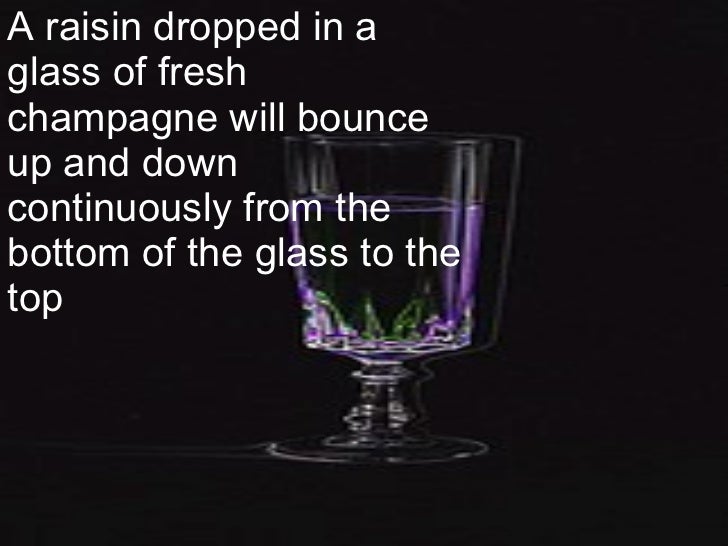A raisin dropped in a glass of fresh champagne will bounce up and down continually from the bottom of the glass to the top

A Raisin’s Fascinating Dance in Champagne: Exploring the Physics Behind

Champagne is a beverage that has fascinated both connoisseurs and casual drinkers for centuries. Its distinct bubbles and vibrant effervescence add an element of celebration to any occasion. But did you know that dropping a humble raisin into a glass of fresh champagne can produce an intriguing visual spectacle?
Contrary to expectations, a raisin dropped in champagne does not sink to the bottom nor simply float on the surface. Instead, it embarks on a mesmerizing journey, bouncing up and down continuously from the bottom of the glass to the top. This phenomenon may sound like magic, but it can be explained through the principles of physics.
First, let’s delve into the science behind the fizziness of champagne. The bubbles in champagne primarily consist of carbon dioxide gas. During the fermentation process, yeast consumes sugar and produces alcohol and carbon dioxide as byproducts. As the sealed bottle of champagne is opened, the pressure inside decreases, causing the carbon dioxide to escape in the form of bubbles.
Now, here’s where the raisin enters the stage. When a raisin is dropped into a glass of champagne, the carbon dioxide bubbles adhere to its wrinkled surface. As these tiny carbon dioxide bubbles cling to the raisin, they provide buoyancy, lifting it upwards. The raisin is thus able to defy gravity and rise to the surface.
As the raisin reaches the top of the glass, something interesting occurs. The carbon dioxide bubbles that initially propelled the raisin begin to detach and rise to the surface, while some dissolve into the surrounding liquid. This reduction in buoyancy causes the raisin to lose its upward momentum, and it starts to sink back down to the bottom.

During this descent, the raisin essentially acts as a catalyst for the formation of new bubbles. Its rough surface provides nucleation sites where carbon dioxide bubbles can form and grow in size. These newly formed bubbles further contribute to the raisin’s buoyancy, propelling it back up again.
This mesmerizing dance of the raisin in champagne continues indefinitely, creating a visual spectacle that is both intriguing and enchanting to witness. But it’s not just an intriguing party trick; it also showcases the fundamental laws of physics in action.
Understanding the physics behind this phenomenon can open doors to a deeper appreciation of the world around us. It reminds us that even the simplest of objects, like a raisin, can interact with their surroundings in unexpected ways, defying our initial expectations. So the next time you sip on a glass of champagne, take a moment to savor the dance of the raisin and marvel at the wonders of the natural world.
Related Posts
Quick Links
Legal Stuff

